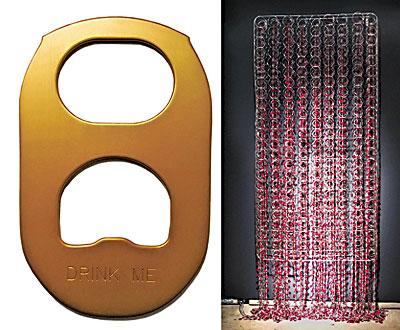Transforming Obsolescence

Anthropologists and archaeologists often say that much can be learned about a culture by its trash. That may be less true today with recycling, or perhaps even more so.
Alice Hope, an East Hampton artist, has found both meaning and aesthetic pleasure in metal tabs, the fulcrums that give access to the soda, beer, and energy drinks in aluminum cans. She made this discovery not in her own bins but in a tour of a recycling center, where a 700-pound box of tabs captured her imagination. While the sheer ordinariness of the object was an initial turnoff, she came to embrace its universality and the compact perfection in its “balance of positive and negative space.”
Struck by both the good-citizen impulse that led to such a massive collection as well as the consumption that produced it, she devised works and objects that either collected the forms as they were, blew them up to heroic proportions, or subverted them entirely. Her current exhibition, at the Ricco/ Maresca Gallery in Chelsea through May 24, includes a 3-D printed facsimile of a tab and two-foot-high anodized aluminum engraved sculptures of tabs with a golden cast that say “Drink Me.”
Then there are the tabs themselves, collected in clear bins, piled on the floor, embedded in resin, or utterly transformed as part of an LED-backlit sculpture, structured by turtle nets, or attached to ball chain to resemble cords of fiber or wavy hair. In another piece, the artist has taken an old metal box spring and nickel-plated it, draping the long strands of ball chain with red anodized tabs. It is reminiscent of those beaded curtains hung in harems or fortune-telling parlors, with a vaguely Islamic feeling in its elaborate patterning.
The installation makes the most of these different explorations, moving toward and away from the found object to something else that transcends it. What might appear most off-topic of all in the room are actually pieces that tie Ms. Hope’s current work to her prior explorations. Lined up as airplane windows, as she puts it, she has framed magnetic-field viewing film activated by the ferrite magnets that often populate her other works. The frames mimic the shape of the windows and also the outline of the aluminum tabs. She said the pop of the cans that comes from the in-flight drinks cart was another thing she was thinking about in these pieces.
The work in this show is fascinating, playing off the artist’s characteristic obsessiveness and channeling it toward new materials and conclusions. In recent years, there had been a certain comfort level in knowing what to expect from Ms. Hope’s installations. That she can find new avenues to explore her interests and imbue them with meaning — from the loss of turtles, to commodification of art, obsolescence, and consumption — demonstrates an imaginative and curious mind constantly attuned to the visual and cultural cues around her. She is a tour guide for unique journeys one doesn’t mind taking again and again.
